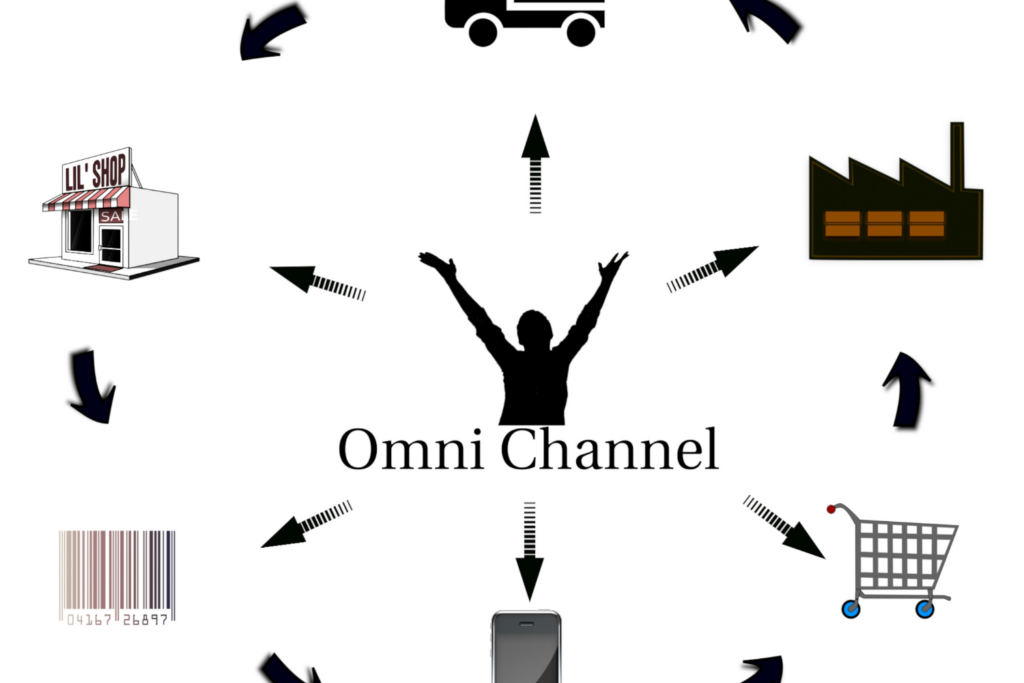ntroduction
IUnleashing the Power of Omnichannel Strategies: Transforming Fragmented Marketing into Seamless Success today’s competitive business landscape, achieving revenue and sales growth is a top priority for companies across industries. However, traditional marketing approaches often fail to meet customers’ expectations and provide a seamless experience. Fragmented marketing, characterized by disconnected and disjointed channels, undermines customer satisfaction, loyalty, and retention rates. To overcome these challenges, businesses are turning to the power of omnichannel strategies – a holistic approach that integrates all customer touchpoints and delivers a seamless experience across channels.
Understanding Fragmented Marketing
The Pitfalls of Siloed Marketing Channels
Fragmented marketing occurs when companies operate various channels independently, without proper coordination or integration. This approach creates silos, where each channel functions separately, often leading to inconsistent messaging, disjointed experiences, and wasted resources. Siloed marketing channels fail to provide a cohesive brand experience, resulting in confusion and frustration among customers.
Challenges faced by Fragmented Marketing Approaches
Fragmented marketing approaches present several challenges that hinder businesses from achieving marketing success. Without a unified strategy, organizations struggle to gather and analyze customer data effectively. Inaccurate or incomplete data leads to suboptimal decision-making and ineffective targeting. Moreover, inconsistent messaging across channels dilutes brand identity and messages, preventing customers from forming a strong connection with the brand.
Customer Dissatisfaction: The Cost of Fragmentation
Fragmented marketing not only impacts a company’s internal operations but also takes a toll on customer satisfaction. Inconsistent experiences, lack of personalization, and disjointed interactions across channels lead to frustrated customers and hinder the potential for long-term loyalty. Customer dissatisfaction can result in reduced repeat purchases, increased churn rates, and negative word-of-mouth, ultimately impacting revenue and profitability.
The Rise of Omnichannel Strategies
Exploring the Concept of Omnichannel Marketing
Omnichannel marketing represents a paradigm shift in how businesses approach customer engagement. Unlike traditional multichannel approaches, which focus on operating multiple channels independently, omnichannel strategies aim to seamlessly integrate all customer touchpoints into a unified and cohesive experience. This means that customers can transition seamlessly between channels, enjoying the same level of service, personalization, and consistency at every interaction.
Embracing Synergy: The Power of Holistic Customer Experiences
At the core of omnichannel marketing is the recognition that customers expect a seamless and fluid experience across all touchpoints. By integrating channels, businesses can provide a cohesive journey that aligns with customers’ preferences and behaviors. This synergy enables companies to deliver personalized offerings, targeted promotions, and consistent messaging, resulting in heightened customer satisfaction and increased loyalty.
Enhancing Brand Consistency across Channels
One of the key advantages of omnichannel strategies is the ability to maintain brand consistency across all channels. By unifying messaging, visuals, and tone of voice, businesses can create a strong and recognizable brand identity. Consistency builds trust and familiarity, allowing customers to develop a deeper connection with the brand and fostering long-term loyalty.
Key Components of a Successful Omnichannel Strategy
Comprehensive Data Integration and Analysis
To execute a successful omnichannel strategy, businesses need to have a robust data integration and analysis framework in place. This involves collecting customer data from various touchpoints, including online and offline interactions, analyzing it to gain insights, and leveraging those insights to deliver personalized experiences. By harnessing data effectively, companies can understand customer preferences, anticipate their needs, and tailor interactions accordingly.
Seamless Cross-Channel Communication
Effective communication is essential in an omnichannel strategy. Businesses must ensure a seamless flow of information between channels, allowing customers to transition effortlessly. This involves integrating backend systems, such as customer relationship management (CRM) and inventory management systems, to provide real-time data across channels. By enabling employees with access to customer information, businesses can deliver consistent and personalized experiences regardless of the channel.
Personalization at Scale: Tailoring Experiences for Each Channel
Personalization lies at the heart of successful omnichannel strategies. By leveraging data insights, businesses can craft hyper-targeted messages, recommendations, and promotions tailored to each customer’s preferences and behaviors. Whether it’s through dynamic website content, personalized emails, or customized advertisements, personalization enhances the customer experience and drives engagement.
Implementing Omnichannel Strategies: Best Practices
Mapping the Customer Journey: Identifying Touchpoints
A crucial step in implementing an omnichannel strategy is mapping the customer journey. By understanding how customers interact with the brand across channels, businesses can identify key touchpoints and optimize each stage of the journey. Mapping the customer journey helps identify pain points, opportunities for improvement, and areas where personalization can make a significant impact.
Syncing Online and Offline Experiences
In an omnichannel world, it is essential to bridge the gap between online and offline experiences seamlessly. For brick-and-mortar stores, this means integrating digital capabilities, such as click-and-collect, in-store mobile apps, or virtual reality experiences. Conversely, for e-commerce businesses, it involves providing offline options like same-day delivery or physical pop-up stores. By unifying online and offline experiences, businesses can meet customers’ expectations and provide a seamless journey regardless of their preferred channel.
Leveraging Technology: The Role of Automation and AI

Technology plays a critical role in executing omnichannel strategies. Automation and artificial intelligence (AI) can streamline processes, enhance personalization, and deliver consistent experiences across channels at scale. AI-powered chatbots, for example, enable businesses to provide instant and personalized customer service, while smart speakers unlock new opportunities for voice commerce. By harnessing the power of technology, businesses can amplify their marketing efforts and drive customer engagement.
Overcoming Challenges in the Omnichannel Landscape
Breaking Down Internal Silos: Building a Collaborative Culture
One of the key challenges in implementing omnichannel strategies is breaking down internal silos within organizations. By fostering a collaborative culture, businesses can ensure that teams across departments work together seamlessly, making data sharing and communication fluid. Collaboration fosters creativity, innovation, and efficiency, enabling businesses to execute a unified omnichannel strategy successfully.
Privacy and Data Security: Balancing Personalization and Customer Trust
While personalization is a cornerstone of omnichannel strategies, businesses must be mindful of customer privacy and data security concerns. Implementing robust data protection measures and transparent privacy policies demonstrates a commitment to customer trust. By striking the right balance between personalization and data security, businesses can build strong and lasting relationships with their customers.
Adapting to Evolving Customer Preferences
In the fast-paced digital age, customer preferences and behaviors rapidly evolve. Successful businesses must continuously monitor and adapt to these changes to stay relevant. Flexibility and agility are vital, allowing companies to capitalize on emerging trends and technologies, thereby keeping their omnichannel strategies fresh and engaging for customers.
Case Studies: Success Stories of Companies Implementing Omnichannel Strategies
Company A: Seamlessly Engaging Customers across Channels
One success story is Company A, a retail brand that successfully integrated its physical stores, e-commerce platform, and social media channels. By leveraging customer data across these channels, Company A was able to deliver personalized recommendations both online and in-store, resulting in increased customer satisfaction and loyalty. Their holistic approach created a seamless shopping experience, enhancing brand perception and revenue growth.
Company B: Harnessing Data to Drive Personalized Experiences
Company B, an e-commerce giant, adopted an omnichannel approach that focused on utilizing customer data to deliver highly personalized experiences. By analyzing customer behaviors and preferences, they tailored product recommendations, email campaigns, and advertisements, resulting in improved conversion rates and higher customer engagement. Company B’s data-driven omnichannel strategy empowered customers to feel understood and valued, fostering long-term loyalty.
Company C: Delivering Consistency and Convenience at Scale
Hospitality brand Company C successfully implemented an omnichannel strategy that provided consistency and convenience across channels. By integrating online booking systems, mobile apps, and onsite services, they offered a seamless guest experience from start to finish. Guests could easily book accommodations, access concierge services, and provide feedback across multiple touchpoints, enhancing their satisfaction and loyalty. Company C’s commitment to delivering a unified experience set them apart from competitors and drove growth in the hospitality industry.
Summary and Key Takeaways
By embracing omnichannel strategies, businesses can transform their fragmented marketing approaches into seamless success. Unifying touchpoints, leveraging data insights, and delivering personalized experiences across channels drive revenue and sales growth. Implementing best practices, such as mapping the customer journey, syncing online and offline experiences, and leveraging technology, helps overcome challenges in the omnichannel landscape. Successful case studies highlight the power of omnichannel strategies in different industries, including retail, e-commerce, hospitality, and finance. By unleashing the potential of omnichannel marketing, businesses can combine channels, unify experiences, and amplify results, ultimately achieving marketing success.
Frequently Asked Questions (FAQs)
What is the difference between omnichannel and multichannel marketing?
While both omnichannel and multichannel marketing involve interacting with customers through various channels, the key difference lies in the level of integration and consistency. Multichannel marketing refers to operating multiple channels independently, whereas omnichannel marketing aims to seamlessly integrate channels, creating a unified and consistent customer experience across touchpoints.
How do I integrate data from different channels in an omnichannel strategy?
Integrating data from different channels in an omnichannel strategy requires a comprehensive data management system. This system should collect data from various touchpoints, consolidate it, and enable seamless analysis and insights extraction. By integrating data effectively, businesses can gain a comprehensive understanding of their customers and tailor experiences accordingly.
Defining Omnichannel Strategies: Embracing the Fluidity
Omnichannel strategies revolutionize the way businesses approach customer engagement by providing a seamless and fluid experience across all touchpoints. By breaking down internal silos, leveraging technology, and focusing on personalized customer experiences, businesses can transform fragmented marketing into seamless success.
The Growing Importance of Omnichannel in Marketing
As customer expectations continue to evolve, the importance of omnichannel marketing grows. Businesses that prioritize integrating channels, delivering personalized experiences, and providing consistency across touchpoints are better positioned to meet customer needs and drive long-term loyalty. The power of omnichannel strategies lies in its ability to create a cohesive and seamless journey that amplifies marketing success.
You can also read this From Zero to Hero How Omnichannel Marketing can Skyrocket Your Sales
You can also read this Embracing the Era of Omnichannel & Creating Consistency Across Channels




























































